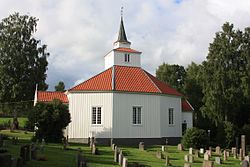Mykland (municipality)
Former municipality in Aust-Agder, Norway From Wikipedia, the free encyclopedia
Mykland is a former municipality in the old Aust-Agder county in Norway. The 306-square-kilometre (118 sq mi) municipality existed from 1876 until 1967 when it was merged into the neighboring municipality of Froland in what is now Agder county. Mykland included the inland areas between the rivers Tovdalsåna and the Rettåna (a tributary of the river Otra). The administrative centre was the village of Mykland where the Mykland Church is located.[1]
Mykland Municipality
Mykland herred | |
|---|---|
 View of the local Mykland Church | |
 Aust-Agder within Norway | |
 Mykland within Aust-Agder | |
| Coordinates: 58.6320°N 08.2880°E | |
| Country | Norway |
| County | Aust-Agder |
| District | Østre Agder |
| Established | 1 Jan 1876 |
| • Preceded by | Åmli Municipality |
| Disestablished | 1 Jan 1967 |
| • Succeeded by | Froland Municipality |
| Administrative centre | Mykland |
| Area (upon dissolution)[1] | |
• Total | 306 km2 (118 sq mi) |
| Population (1967) | |
• Total | 604 |
| • Density | 2.0/km2 (5.1/sq mi) |
| Demonyms | Myklending Mykling[2] |
| Time zone | UTC+01:00 (CET) |
| • Summer (DST) | UTC+02:00 (CEST) |
| ISO 3166 code | NO-0932[3] |
The main roads through the municipality were Norwegian County Road 42 and Norwegian County Road 413.
History
Summarize
Perspective

The parish of Mykland was originally part of the municipality of Åmli. Mykland was established as a municipality in 1876, when the southern parish of Mykland was split off to be a separate municipality. Initially, the population of Mykland was 663. This left Åmli with a population of 2,564. During the 1960s, there were many municipal mergers across Norway due to the work of the Schei Committee. After much debate in Mykland, a vote was held on whether or not to join Åmli to the north, Froland to the east, or Birkenes to the south. A majority voted for Froland, some voted for Åmli, and no one voted to join Birkenes.[4] Therefore, on 1 January 1967, Mykland was merged into the neighboring municipality of Froland. Prior to the merger, Mykland had a population of 604. On 1 January 1970, the uninhabited properties of Neset and Råbudal in Froland (which had been a part of Mykland until 1967) were moved to Birkenes municipality.[5]
Name
The municipality (originally the parish) is named after the old Mykland farm (Old Norse: Myklaland) since the first Mykland Church was built there. The first element is the genitive case of the word mikill which means "great" or "prominent". The last element is land which means "land" or "district".[1][6]
Government
Summarize
Perspective
While it existed, this municipality was responsible for primary education (through 10th grade), outpatient health services, senior citizen services, unemployment, social services, zoning, economic development, and municipal roads. During its existence, this municipality was governed by a municipal council of directly elected representatives. The mayor was indirectly elected by a vote of the municipal council.[7]
Mayors
The mayors (Norwegian: ordfører) of Mykland:[8]
- 1876-1894: Ellef J. Løvrak
- 1895-1898: Notto N. Mykland
- 1899-1901: Ellef J. Løvrak
- 1902-1907: Notto N. Mykland
- 1908-1910: Nils Auestad
- 1911-1913: Olav Auestad
- 1914-1919: Syvert Mjaaland
- 1920-1922: Gregorius Mjaaland
- 1923-1928: Notto N. Mykland
- 1929-1931: Andreas N. Mykland
- 1932-1934: Tarald O. Mykland
- 1935-1937: Knut Aasen
- 1938-1940: Gunnar Askland
- 1945-1945: Knut Skauland
- 1946-1959: Kjetil Tveit
- 1960-1963: Olav Skripeland
- 1964-1966: Trygve Usterud
Municipal council
The municipal council (Herredsstyre) of Mykland was made up of 13 representatives that were elected to four year terms. The tables below show the historical composition of the council by political party.
| Party name (in Norwegian) | Number of representatives | |
|---|---|---|
| Labour Party (Arbeiderpartiet) | 5 | |
| Centre Party (Senterpartiet) | 1 | |
| Liberal Party (Venstre) | 4 | |
| Local List(s) (Lokale lister) | 3 | |
| Total number of members: | 13 | |
| Party name (in Norwegian) | Number of representatives | |
|---|---|---|
| Labour Party (Arbeiderpartiet) | 7 | |
| Centre Party (Senterpartiet) | 4 | |
| Liberal Party (Venstre) | 2 | |
| Total number of members: | 13 | |
| Party name (in Norwegian) | Number of representatives | |
|---|---|---|
| Labour Party (Arbeiderpartiet) | 8 | |
| Joint List(s) of Non-Socialist Parties (Borgerlige Felleslister) | 5 | |
| Total number of members: | 13 | |
| Party name (in Norwegian) | Number of representatives | |
|---|---|---|
| Labour Party (Arbeiderpartiet) | 8 | |
| Joint List(s) of Non-Socialist Parties (Borgerlige Felleslister) | 4 | |
| Total number of members: | 12 | |
| Party name (in Norwegian) | Number of representatives | |
|---|---|---|
| Labour Party (Arbeiderpartiet) | 7 | |
| Joint List(s) of Non-Socialist Parties (Borgerlige Felleslister) | 5 | |
| Total number of members: | 12 | |
| Party name (in Norwegian) | Number of representatives | |
|---|---|---|
| Labour Party (Arbeiderpartiet) | 7 | |
| Joint List(s) of Non-Socialist Parties (Borgerlige Felleslister) | 5 | |
| Total number of members: | 12 | |
| Party name (in Norwegian) | Number of representatives | |
|---|---|---|
| Labour Party (Arbeiderpartiet) | 7 | |
| Joint list of the Farmers' Party (Bondepartiet) and the Liberal Party (Venstre) | 5 | |
| Total number of members: | 12 | |
| Note: Due to the German occupation of Norway during World War II, no elections were held for new municipal councils until after the war ended in 1945. | ||
See also
References
Wikiwand - on
Seamless Wikipedia browsing. On steroids.
